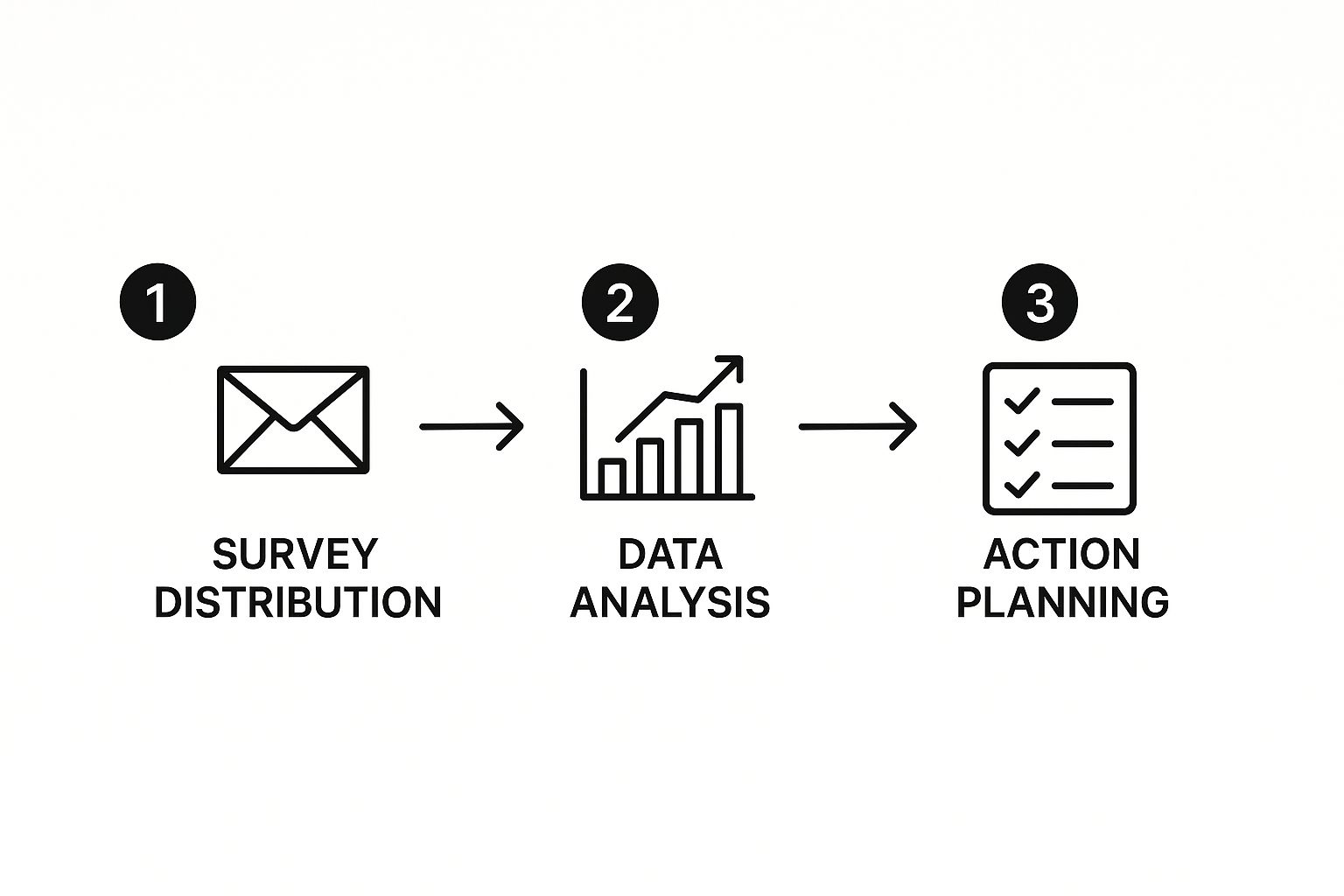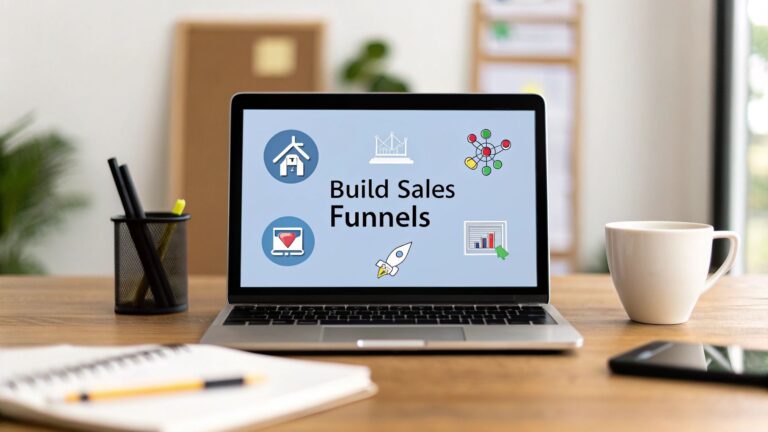How to Improve Customer Experience & Build Loyalty Quickly
Improving your customer experience is more than just a set of actions; it’s a mindset shift. It means going from a reactive support model to a proactive strategy that actually anticipates what your customers need, often before they even ask. This turns your service department from a cost center into one of your most powerful engines for growth.
Why Customer Experience Is Your New Competitive Edge

Let's be real—competing on price and features is a race to the bottom. The modern battleground for business isn't about what you sell, but how you sell it and support it. The customer experience (CX) is where brands are won and lost today.
Customers don’t just compare you to your direct competitors anymore. They compare you to the best service they've ever received, whether that was from a coffee shop, an e-commerce giant, or a SaaS platform. That’s a high bar.
This reality forces us to move away from simply putting out fires. It’s about building a framework that anticipates customer needs and solves problems before they even happen.
The Foundation of Modern CX
A truly effective approach to customer experience isn't just about being friendly. It's built on a foundation of being effective, efficient, and empathetic. From what I’ve seen, that foundation rests on a few key pillars.
- Unified Data: Your marketing, sales, and support teams need to be looking at the exact same customer information. Nothing is more frustrating for a customer than having to repeat their story every time they talk to someone new.
- Smart Personalization: This is about more than just using a first name in an email. It’s offering genuinely relevant advice, product recommendations, and support based on a customer's specific history and behavior.
- Continuous Feedback: You have to build systems to listen to your customers, analyze what they're telling you, and—this is the most important part—actually act on that feedback to make real improvements.
This isn't just a hunch. We're seeing the data back it up. A staggering 89% of businesses expect to compete primarily on the basis of customer experience. At the same time, 65% of consumers now expect personalized experiences from every brand they do business with. The gap between expectation and reality is where you can win.
To truly build a winning CX program, it helps to break it down into its core components. The table below outlines the key pillars that I've found are essential for any modern strategy.
Key Pillars of a Modern CX Strategy
| Pillar | Description | Business Impact |
|---|---|---|
| Data & Insights | Consolidating customer data from all sources into a single view to understand behavior, preferences, and pain points. | Enables proactive support, personalization, and informed decision-making across the entire company. |
| Personalization | Using data to tailor communications, offers, and support interactions to the individual customer's context and history. | Increases engagement, conversion rates, and builds a stronger emotional connection with the brand. |
| Omnichannel Consistency | Ensuring a seamless and consistent experience for customers as they move between channels (e.g., website, mobile app, social media, in-person). | Reduces customer friction and frustration, leading to higher satisfaction and a more cohesive brand perception. |
| Automation | Implementing intelligent automation for routine tasks and queries to provide instant support and free up human agents for complex issues. | Improves efficiency, reduces operational costs, and provides 24/7 availability for basic customer needs. |
| Feedback Loop | Systematically collecting, analyzing, and acting on customer feedback (e.g., surveys, reviews) to continuously improve processes and offerings. | Drives product innovation, reduces churn by addressing issues quickly, and shows customers their voice is valued. |
Each of these pillars works together to create an experience that feels cohesive, intuitive, and valuable to the customer.
The core idea is simple: when customers feel understood and valued, they don't just stay; they become advocates. They spend more, remain loyal longer, and tell others about their positive interactions.
This is the very essence of turning customer experience from a necessary expense into your most valuable asset. If you're looking to dig deeper into building out a program that delivers these kinds of results, our guide on Customer Experience Management Best Practices is a great place to start. It provides a more detailed look at how to set yourself apart in a crowded market.
Map Your Customer Journey to Find What Matters
If you want to create an experience customers love, you have to walk a mile in their shoes first. A customer journey map is the tool that lets you do just that. It's about getting out of your own head and seeing your business exactly as your customers do, warts and all.
This isn't just about making a pretty flowchart for the office wall. Think of it as a living, breathing blueprint that uncovers the real friction points and those critical “moments of truth” that make or break their perception of your brand. These moments could be anything from a clunky checkout flow to a surprisingly fast and friendly support chat.
To build this map, you need to become a data detective. You’re looking for clues at every single place a customer interacts with you. Start digging into:
- Website Analytics: Where are people getting stuck and leaving? Which pages are sending them running for the hills (high bounce rates)?
- Support Tickets: What are the top 3-5 problems or questions that pop up again and again?
- Customer Surveys: Don’t guess—ask them directly how things went after they bought something or got help.
- Social Media Mentions: Eavesdrop on the public conversation. What are people saying when they think you’re not listening?
Identifying Key Stages and Touchpoints
With your data in hand, it's time to start plotting the journey. Your goal here is to outline the major stages everyone goes through: Awareness, Consideration, Purchase, and Post-Purchase Support. Under each of these headings, list every single interaction point. No touchpoint is too small.
Using a solid user journey mapping template can give you a great head start. It provides a framework so you don't miss anything, from the first ad a customer sees to the follow-up email they get weeks after their purchase. Laying it all out visually is often when the "aha!" moments happen.
You might find that your sales process is slick and effective, but your post-purchase onboarding is a confusing mess that causes new customers to bail. Journey mapping shows you how all these seemingly separate departments and functions actually create one single experience—which can be either seamless or incredibly frustrating. If you want to dive deeper into connecting these stages, our guide on how to build sales funnels is a great resource.
The real magic of a journey map is the empathy it creates. When your whole team sees the frustrating hoops a customer has to jump through, it lights a fire under everyone to start fixing things.
This image breaks down a simple but powerful process for turning that customer insight into real, tangible improvements.

What this shows is that just collecting feedback isn't enough. The real value comes when you analyze what you’ve found and build a clear action plan. It’s how you turn a customer complaint into your next great strategic advantage.
Using Tech and Data to Create a Seamless Experience

Technology can either be a bridge or a barrier in your customer relationships. The difference really comes down to whether you’re using it to create clarity or just adding to the chaos. The ultimate goal is to build an intelligent, unified view of your customer so that every single interaction feels connected and effortless.
This all starts by tearing down the data silos that plague most businesses. You know the ones I’m talking about—where your marketing, sales, and support teams are all working from different sets of information. When this happens, it’s the customer who pays the price by having to repeat their story over and over again.
Unifying Your Customer Data
This is where a Customer Relationship Management (CRM) system becomes your command center. It’s the one place where every email, phone call, purchase, and support ticket should live, creating a single source of truth that every employee can rely on.
When your teams have access to this unified data layer, they can deliver a completely different level of service. For example, a support agent can immediately see a customer's recent marketing interactions and full purchase history. This context allows them to solve problems without flying blind.
This transparency has a massive impact on the bottom line. In fact, sales teams using a well-integrated CRM system meet their quotas 41% more often, simply because they have better, more timely information. You can dig into more insights on how integrated data improves team performance on superoffice.com.
A unified view transforms customer service from a guessing game into a precise, empathetic science. Every team member, regardless of their department, can pick up the conversation exactly where it left off.
Automating for Efficiency and Personalization
Once your data is centralized, you can start automating intelligently. This isn't about replacing humans; it's about freeing them up to do what they do best: build genuine relationships and solve complex problems.
Just think about all the repetitive tasks that eat up your team's day. These are the perfect candidates for automation.
- Ticket Routing: Automatically assign support tickets to the right agent or department based on keywords or the customer's history.
- Status Updates: Keep customers in the loop about their order status or support query without anyone having to send manual follow-ups.
- Proactive Check-ins: Trigger an automated email or message if a customer hasn't logged in for a while, showing you're paying attention.
A great example is an AI-powered chatbot. It can handle common questions like "Where is my order?" 24/7. This gives the customer an instant answer and saves your human agents’ brainpower for the high-stakes issues that demand real empathy and critical thinking.
The key is to use technology to handle the predictable, so your team can master the exceptional. This is a fundamental step in learning how to improve customer experience without just throwing more people at the problem. The right tech stack doesn't just make you faster; it makes you smarter and more tuned in to what your customers actually need in that moment.
Personalizing Experiences That Drive Real Loyalty
https://www.youtube.com/embed/ecOSOOjL4T8
Let's be honest, generic outreach doesn't work anymore. True loyalty is earned when customers feel like you actually get them—not just as another number in your CRM, but as individuals. This means we have to move way past just plopping their first name into an email template. We need to create experiences that are genuinely shaped by their real-world behavior.
The bedrock of any good personalization strategy is smart segmentation. Forget about lumping customers into broad buckets like age or location. The real magic happens when you segment based on what they do. Think about grouping them by their purchase history, the features they use most often, or even their past support tickets.
This behavioral data is pure gold. It lets you serve up recommendations and support that feel spot-on because they're based on how that person has actually interacted with your brand.
From Reactive to Proactive Personalization
One of the best ways to show a customer you understand them is to anticipate what they need before they even ask. This is where you graduate from simply reacting to their requests to proactively engaging with them. It’s all about staying one step ahead.
Picture an online coffee shop. They see a customer has bought the same bag of single-origin espresso beans three times. Instead of just sitting back and waiting for the fourth order, their system automatically triggers a friendly email a week before they're likely to run out. Maybe it even includes a small discount if they subscribe.
This isn't just another transaction; it's a thoughtful, helpful interaction. The customer feels looked after, and the business locks in predictable revenue. This is the kind of service that turns a one-time buyer into a lifelong fan.
Tailoring Every Touchpoint
Personalization shouldn't be a one-off tactic you only use in marketing emails. To really work, it needs to be woven into every single touchpoint. This creates a cohesive, intelligent experience that builds a ton of trust over time.
Here are a few ways this can look in the real world:
- Website Content: You can dynamically change homepage banners or product recommendations based on a visitor's past browsing habits. If someone has been checking out project management tools, it makes zero sense to show them ads for sales software.
- Support Interactions: Imagine a high-value customer submits a support ticket. The system can automatically flag it for priority routing. When the agent picks it up, they see the customer's entire history at a glance, allowing them to provide a fast, super-relevant solution without asking a bunch of repetitive questions.
- Product Recommendations: Use data to suggest things that genuinely complement what a customer already owns. For a SaaS company, this could mean suggesting a powerful integration after a user has clearly mastered a core feature.
When you engage with customers this deeply, they start to feel like they have a genuine relationship with your brand.
To take that connection even further, you can foster a sense of belonging by building a community around your brand. Learning how to build an online community can turn your customer base into a thriving network of advocates. When people feel connected to both your brand and each other, their loyalty becomes unshakable.
Empowering Your Team for Unforgettable Service

Your technology and data are powerful, but your people are the true heart of your customer experience. No amount of automation can truly replace a skilled, empathetic person who genuinely wants to solve a problem. They are the ones who turn frustrating moments into memorable resolutions.
Investing in your employee experience (EX) is one of the smartest CX investments you can possibly make. When your team feels supported, valued, and trusted, that positive energy flows directly to your customers. It’s a simple truth: a happy team creates happy customers.
Cultivating Essential Soft Skills
While technical knowledge is table stakes, lasting customer relationships are built on soft skills. Your training program needs to go beyond product features and dive deep into core competencies like active listening, empathy, and clear communication. These are the skills that allow your team to understand a customer’s real frustration, not just the surface-level ticket.
For instance, active listening isn’t just about hearing words. It’s about picking up on the customer’s tone and underlying emotion, which helps an agent deliver a solution that feels both effective and reassuring.
The goal is to move beyond transactional support. An empowered agent doesn't just close a ticket; they strengthen the customer relationship by making the person on the other end feel heard and respected.
This shift in focus has never been more critical. Customer expectations are sky-high, and patience is razor-thin. By 2025, a staggering 72% of customers expect immediate service. As we've seen from other data on how customer expectations are reshaping service on zendesk.com, more than half will switch to a competitor after just one bad experience.
Granting Autonomy and Providing the Right Tools
Empowerment isn't just a buzzword—it's about giving your team the authority to make decisions on the spot. Nothing derails a good customer interaction faster than hearing, "I need to ask my manager." Agents need the autonomy to resolve issues during the first contact whenever possible.
When agents can solve problems on the first call, it doesn't just make customers happier; it has a direct, measurable impact on the business.
First-Contact Resolution Impact on Business Metrics
This table illustrates the direct correlation between empowering agents for first-contact resolution and key business growth indicators.
| CX Metric | Direct Business Impact | Supporting Statistic |
|---|---|---|
| Customer Loyalty | Higher retention rates, increased LTV | 67% of customer churn is preventable if the issue is resolved on the first interaction. |
| Operational Efficiency | Lower cost-per-contact, higher agent productivity | Resolving an issue on the first contact is 30-50% cheaper than multiple follow-ups. |
| Brand Reputation | Positive word-of-mouth, better reviews | Customers are 2x more likely to share a positive experience after a quick resolution. |
To achieve this level of service, your team needs a few things from you:
- Clear guidelines on what they can offer, like discounts or credits, without needing to escalate.
- Access to a unified customer view so they have all the context they need to make smart, informed decisions.
- Modern tools that streamline their work, letting them focus on the customer instead of fighting with clunky software.
Giving your team the right resources is a huge part of this. For example, using some of the best AI tools for project management can help organize complex customer cases and ensure nothing falls through the cracks.
When your team has the freedom and the tools to act, they become true owners of the customer experience.
Build a Feedback Loop That Actually Drives Improvement
A great customer experience isn't a "set it and forget it" kind of thing. It's a living, breathing process of listening, learning, and constantly tweaking your approach. After all, you can't fix a problem you don't even know you have, right? This is why a powerful feedback loop is non-negotiable for any business that’s serious about growth.
This means getting past the old-school annual survey. They have their place, but they often tell you how a customer felt months ago. The real gold is in capturing feedback in the moment, when the experience is still fresh.
Capturing Insights That You Can Actually Use
To really understand what's working and what's not, you need to use a smart mix of feedback tools at critical points in the customer's journey. This gives you both the big-picture score and the nitty-gritty details you need to make real changes.
Here’s what that looks like in practice:
-
Net Promoter Score (NPS): Think of this as your loyalty barometer. You’ll want to ask the classic "how likely are you to recommend us?" question after a major milestone—say, right after a customer completes onboarding or makes their first big purchase.
-
Customer Satisfaction (CSAT): This is for immediate, in-the-moment feedback. A simple "How satisfied were you with this chat?" right after a support ticket is closed gives you an instant read on the quality of your service.
-
Contextual Micro-Surveys: These are tiny, targeted pop-ups that appear based on user behavior. For example, if someone spends a lot of time on your pricing page but doesn't sign up, a quick survey could pop up asking, "Was there anything unclear on this page?" It’s a direct line to understanding hesitation.
The point isn't just to rack up data. It’s to get to the why behind the scores. That’s how you learn how to improve customer experience in a way that truly matters to people.
The most important part of this entire process is closing the loop. It’s one thing to collect feedback, but it’s another thing entirely to show your customers you’re listening by taking action on what they tell you.
When customers see their suggestions lead to actual changes—whether it’s fixing a small bug or overhauling a clunky process—it shows their voice has a real impact. This is one of the most powerful ways to build loyalty and it transforms feedback from just another metric into a genuine conversation.
This proactive approach is also key to keeping customers around. You can learn more about how to reduce customer churn with proactive strategies in our detailed guide. When you act on their input, customers stop being just users; they become partners in your success.
Frequently Asked Questions About Improving CX
As you start digging into improving your customer experience, a few common questions always seem to pop up. Let's tackle two of the big ones I hear all the time from businesses just starting to make these critical changes.
Where Do We Even Begin?
It’s tempting to jump straight to a shiny new piece of technology, but that’s rarely the right first move. The best place to start is with understanding. Before you spend a dime, you absolutely have to get a clear, honest picture of your current customer journey.
Map out every single touchpoint. Go talk to your customer service agents, your sales team, and anyone else on the front lines—they know where the real problems are. Sift through your existing customer feedback, reviews, and support tickets to find the most common points of friction.
You'll often find that the biggest and quickest wins come from fixing the most glaringly obvious problems. This focused approach builds momentum and, just as importantly, shows your team that their efforts are having a tangible impact.
How Can We Tell If We’re Actually Succeeding?
Measuring the customer experience isn’t about chasing a single magic number. To get the full story, you need to look at a combination of metrics that tell you different things.
Here are the essentials:
- Net Promoter Score (NPS): This gives you a high-level view of overall customer loyalty. Are people willing to recommend you?
- Customer Satisfaction (CSAT): This is more transactional. It measures how happy a customer was with a specific interaction, like after a support chat or a new feature tutorial.
- Customer Effort Score (CES): This one is huge. It tells you how easy—or difficult—it was for a customer to get their issue resolved or their question answered.
When you pair these quantitative metrics with qualitative feedback (like comments and survey responses), you get a much clearer view of your progress.
The goal isn't just to collect numbers; it's to turn those insights into action. A good metric is one that helps you make a smarter decision tomorrow than you did today.
Improving your CX is a marathon, not a sprint. It’s a continuous cycle of learning and refining. By focusing on truly understanding your customers, measuring what actually matters, and empowering your team to act, you can build the kind of experiences that create lasting loyalty and fuel real, sustainable growth.
Ready to transform your customer experience with intelligent automation? The experts at MakeAutomation can help you design and implement the systems you need to scale your B2B or SaaS business. Get started with MakeAutomation and build processes that deliver exceptional service.







